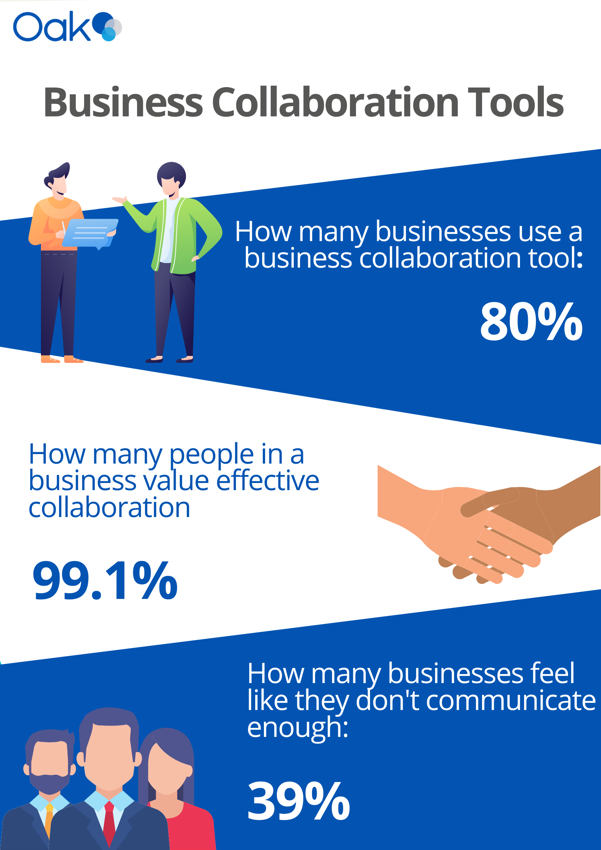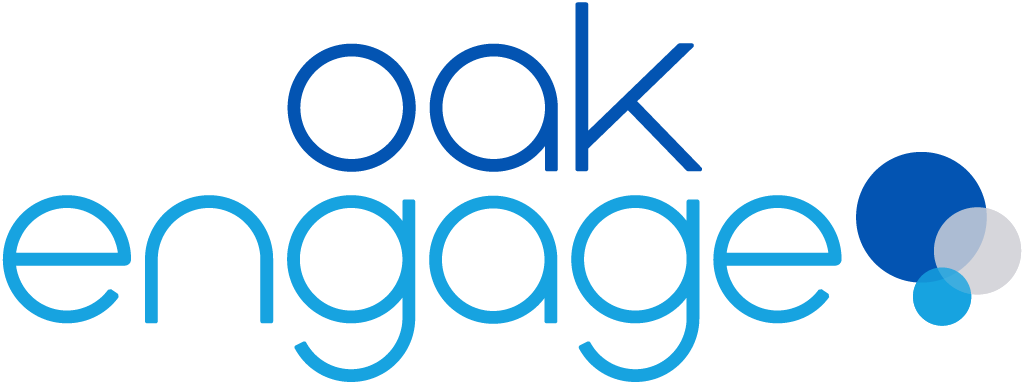Business collaboration tools are becoming increasingly familiar within our workplaces, and with good reason. According to recent studies, businesses that value effective communication and collaboration are nearly 5 times more likely to retain their best employees.
Collaboration has proven links to increasing productivity and ROI and offers businesses a variety of different benefits. Whilst collaboration has always been a staple of the workplace, it’s only now that the extent of its impact upon productivity, engagement and connectivity is being realised.
Collaboration may have always existed as an idea in practice, but with the help of innovative new software, it’s becoming a much more efficient reality. Collaboration traditionally exists in the form of face to face meetings, workshops and other means. Now, the workplace is adorned by a whole host of business collaboration tools. Zoom, Skype, Teams and even Oak's Employee Engagement App make collaboration easier and ultimately more productive.
Business collaboration tools and employee collaboration tools are now shaping the ways in which we work. We have more flexibility and more scope than ever before. From instant messenger to video calls, we can connect with one another from distant locations with all the clarity and transparency as if sat face to face. Whilst business collaboration tools may be becoming commonplace in workplaces around the world, just how can they benefit you?

*Statistics sourced from bit.ai.com
Why We Need Business Collaboration Tools
Collaboration is at the beating heart of any productive workplace. When we work together, we get better results, and businesses know that (well at least the good ones do anyway). This is, in part, is why there’s been such a big push to introduce new ‘collaboration-centric’ employee collaboration tools, software and more within businesses in recent years. Collaboration opens the door for many exciting possibilities, not only for your people but your business as a whole.
Knowledge is power: Collaboration is integral to achieving targets and addressing problems within the workplace. Often, we rely on the wider skill sets of our colleagues to assist us when a problem outside our area of expertise arises; after all, it’s unlikely that one person can solve every problem on their own. Collaboration allows us to pool our experience and utilise an extended skill set that we otherwise wouldn’t have access to. Everyone is different. Each individual has their own distinct strengths and weaknesses.
Inspire creativity: Success is driven by innovation and creativity, the ability to bounce off one another, and share ideas. Collaboration helps employees gain a better understanding of a topic thanks to new perspectives and alternative solutions.
When two people or more come together with different backgrounds and experience, you are exposed to a hybrid melting pot of new and innovative resolutions.
Expand skill set: Engaged employees are always looking for ways to expand their skill set. Having people from different backgrounds working towards a common goal is an ideal opportunity for individuals to build upon their existing experience and trade skills with one another.
For small companies in particular, having an eclectic team of workers can prove advantageous in more ways than one. It not only reduces the expenditure on what you may have to spend on outsourcing for particular skills but it helps save time and money on having your team learn new skills from scratch.
Reduces workload: With the best will in the world, workloads can reach insurmountable levels, leaving you feeling completely bogged down and at a loss as to where to start.
When working with others, we can get more work done in a shorter space of time, helping to boost our overall productivity and morale.
Studies have shown that working together helps teams be 30% more productive and experience increased levels of satisfaction within the workplace.
Old School Collaboration Vs. New School
As we’ve already discussed, employee collaboration tools have evolved out of what was once just an everyday routine in the workplace. These new tools have been designed specifically to enhance collaboration, rather than replace it. Traditional collaboration may have its place, but when it comes to efficiency and practicality, technology wins every time.
Old: Brainstorming
Brainstorming: A method that every company in the world is well acquainted with, brainstorming involves a group of people coming together to voice their opinions and provide ideas on a given topic.
It can be to find a resolution to a problem, come up with a new idea or otherwise, Whilst it’s fairly simple in practice, it’s easy for brainstorming meetings to go off on a tangent, lose coherency and those present lose track of any good ideas that may crap up.
Another inherent problem with a brainstorming meeting is that sometimes, ideas are not fairly represented and people miss out on offering suggestions because the conversation has either moved on or took another turn.
New: Pulse Surveys
Pulse Surveys: When brainstorming, it can pay to have all of your ideas collected and collated in one central location. Pulse Surveys are great ways for companies to get suggestions and ideas from their employees, without the administrative nightmare of noting down every idea or notion.
Comms Platforms: Modern employee collaboration tools often provide the capability for administrators to monitor and arbitrate suggestions from employees and enable users to submit their suggestions anonymously, especially handy for those that feel intimated in group situations.
You can track suggestions and leave a digital paper trail so that you can refer to any important points that may have become lost during the initial meeting.
Alternatively, if it’s still a ‘face to face’ meeting you require, individuals can use software like Teams to ‘raise a hand’ and wait or the right moment to interject. This helps to create a fairer and more balanced discussion.
Old: Peer review
A peer review is an effective way of seeing what your colleagues think of the work you have produced. They can offer different perspectives, insights or even just act as a fresh pair of eyes to catch any wayward spelling mistakes.
Traditionally, this could have been a fairly monotonous affair and could have involved a lot of back and forth with emails or worse yet, hand-written edits! When cross-referencing documents, it’s easy to get wires and crossed and for important points to get lost in the clutter. Documents may not save, get overwritten or even get accidentally deleted.
New: Online collaboration
With simultaneous document editing capabilities on platforms like Google Docs, Onedrive and more, employee collaboration tools enables people work alongside one another in real-time and provide updates and edits in one central location. Work exists in the cloud, so any changes that are made can be easily tracked and saved online.
Users can engage with one another via interactive comments and review processes. This functionality reduces the risk of losing documentation and allows you to have a more efficient and transparent collaboration effort with colleagues.
Old: Email
Email: Trying to communicate with others outside of your immediate circle of colleagues can sometimes prove a little bit tricky. Emails, whilst serving the purpose of communication, are slow and easy to lose track of inboxes get full and cross-contaminated by a range of different senders, emails get lost in junk email, the list goes on and on. For years its been the backbone of any businesses internal comms set-up.
New: Instant Messenger
Instant Messenger is a great way of getting someone’s attention right away. Rather than landing in a cluttered inbox, the message instead pops up as a notification on the user’s desktop letting them know that you’re trying to get in touch.
Instant messengers are designed to engage employees and get them to collaborate to the fullest extent. Completely detachable, Oak Engages messenger panel (for example) allows users to message each other instantly and watch, read or work on a piece of content at the same time.The instant nature of our messenger capability within an employee engagement tool makes work not only much more engaging but far more efficient.
Summary
Having the correct businesses collaboration tools in place to facilitate inter-connectivity between departments is essential if businesses want to maintain a competitive stance in challenging market conditions. Business collaboration tools may be a recent development, but the face of collaboration is always changing. By staying up to date with the latest technology, you’ll be sure to get the most out of your workforce on a consistent and more frequent basis.
Want to find out how Oak's business collaboration tools can help your business? Get in touch with our sales team today.
Want to see more?
Get a demo with one of our digital workplace experts and see how Oak could work for you.


